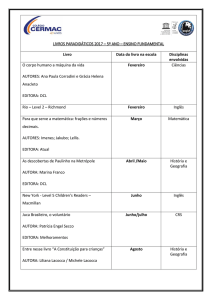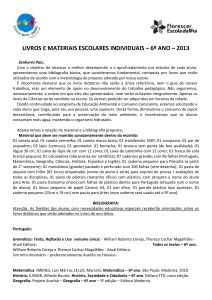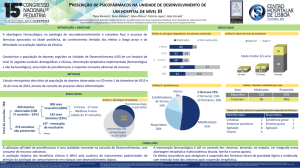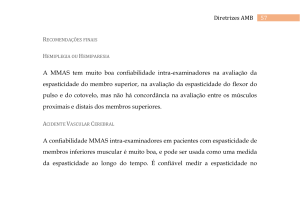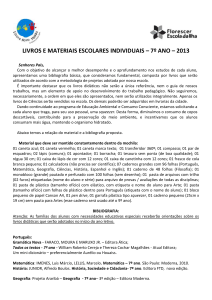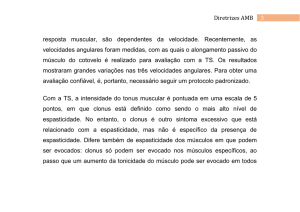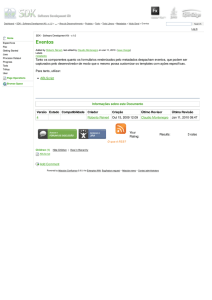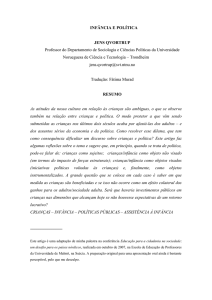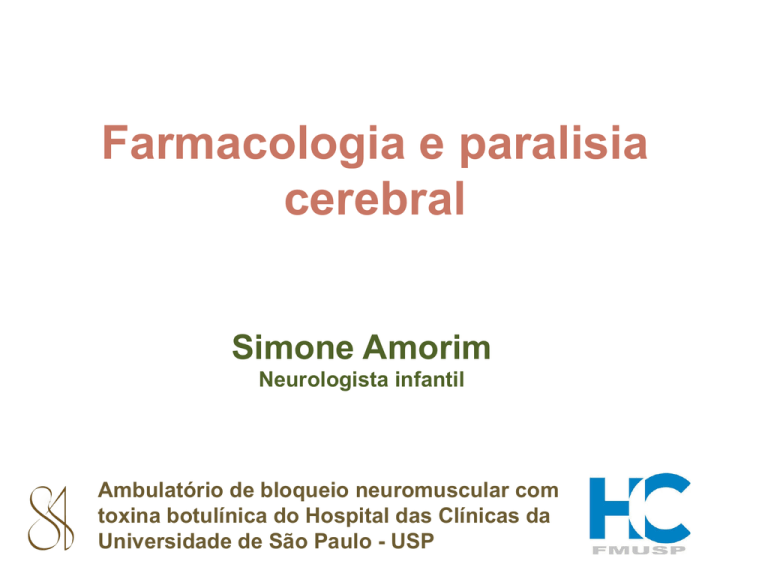
Farmacologia e paralisia
cerebral
Simone Amorim
Neurologista infantil
Ambulatório de bloqueio neuromuscular com
toxina botulínica do Hospital das Clínicas da
Universidade de São Paulo - USP
Farmacologia e PC*
• Distúrbios do humor
• Distúrbios do sono
• Epilepsia
• Dor…
• Hipertonia
• Sialorréia
*Paralisiacerebral
Síndrome do moto neurônio superior
Neural
Não-neural
Hipertonia
Espasticidade
Presença de resistência
muscular, velocidade
dependente e pode variar
com a direção do
movimento articular
Distonia
Rigidez
Contrações musculares
involuntárias e
intermitentes, levando a
movimentos e posturas
anormais ou ambos
Independente de
velocidade e postura.
Pode haver co
contração
Sanger et al., 2003;
Reflexo de estiramento
SMNS
Receptores
aferentes
O
O
X
Aumento na hiperexcitabilidade do reflexo de estiramento /
tonus muscular.
Espasticidade na paralisia cerebral
Transtorno primário (1-3 anos): desequilíbrio de forças,
diminuição do movimento articular e muscular. Transtorno secundário (3-12 anos): Encurtamento de
tendões e músculos. Surgem contraturas e deformidades
osteoarticulares. Transtorno terciário (a partir dos 12 anos):
Compensações do desequilibrio de forças com posturas e
movimentos anormais
Intervenção
precoce!
Paralisia cerebral – Conceitos
Paralisia
cerebral é a maior causa de espasticidade na
criança, cerca de 80% das crianças com PC são afetadas
porespasticidade.
Delgado, M et al., 2010
Paralisia cerebral (PC) descreve um grupo de distúrbios do
movimento e postura, causando limitação da atividade, os
quais são atribuídos a injúrias que ocorreram no
desenvolvimento do cérebro no período pré, peri ou pós
natal. No entanto, as desordens motoras são
frequentemente acompanhadas por distúrbios da
sensibilidade, cognição, comunicação, percepção,
comportamento e/ou epilepsia.
Bax et al., 2005
Paralisia cerebral – Prevalência
DEVELOPMENTAL MEDICINE & CHILD NEUROLOGY
REVIEW
An update on the prevalence of cerebral palsy: a systematic
review and meta-analysis
MARYAM OSKOUI 1
| FRANZINA COUTINHO 2 | JONATHAN
DYKEMAN 3
| NATHALIE JETT !E3 |
TAMARA PRINGSHEIM 4
A prevalência da
paralisia cerebral
tem se mantido
1 Departments of Pediatrics and Neurology, McGill University, Montreal, Quebec; 2 School of Physical and Occupational Therapy, McGill University, Montreal, Quebec;
3 Department of Clinical Neurosciences and Hotchkiss Brain Institute, Department of Community Health Sciences and Institute of Public Health, University of Calgary,
Calgary, Alberta; 4 Departments of Clinical Neurosciences and Pediatrics, University of Calgary, Calgary, Alberta, Canada.
constante nos
Correspondence to Dr Maryam Oskoui, Departments of Pediatrics and Neurology, McGill University, Montreal Children’s Hospital, 2300 Tupper Street, A-512, Montreal, Quebec,
Canada H3H 1P3. E-mail: [email protected]
últimos anos,
principalmente em
virtude da melhora
PUBLICATION DATA
AIMS The aim of this study was to provide a comprehensive update on (1) the overall
Accepted for publication 22nd October 2012.
Published online 24th January 2013.
prevalence of cerebral palsy (CP); (2) the prevalence of CP in relation to birthweight; and (3)
the prevalence of CP in relation to gestational age.
METHOD A systematic review and meta-analysis was conducted and reported, based on the
PRISMA (Preferred Reporting Items for Systematic Reviews and Meta-analyses) statement.
Population-based studies on the prevalence of CP in children born in 1985 or after were
selected. Statistical analysis was carried out using computer package R, version 2.14.
RESULTS A total of 49 studies were selected for this review. The pooled overall prevalence of
CP was 2.11 per 1000 live births (95% confidence interval [CI] 1.98–2.25). The prevalence of
CP stratified by gestational age group showed the highest pooled prevalence to be in
children weighing 1000 to 1499g at birth (59.18 per 1000 live births; 95% CI 53.06–66.01),
although there was no significant difference on pairwise meta-regression with children
weighing less than 1000g. The prevalence of CP expressed by gestational age was highest in
children born before 28 weeks’ gestation (111.80 per 1000 live births; 95% CI 69.53–179.78;
p<0.0327).
INTERPRETATION The overall prevalence of CP has remained constant in recent years despite
increased survival of at-risk preterm infants.
na sobrevida dos
RN pré termos
2.11 por 1000 nascidos vivos
OSKOUI et al., 2013
Gross Motor Function Classification System – GMFCS
GMFCS E & R between 6th and 12th birthday:
Descriptors and illustrations
GMFCS Level I
Children walk at home, school, outdoors and in the
community. They can climb stairs without the use
of a railing. Children perform gross motor skills such
as running and jumping, but speed, balance and
coordination are limited.
GMFCS I: 35,5%
˜ 60%
GMFCS Level II
GMFCS II: 24,5%
I-II-III:
Melhorarmarchae
função
Children walk in most settings and climb stairs
walking long distances and balancing on uneven
III-IV:
Principalmente
melhorarpostura
Children may walk with physical assistance, a handheld mobility device or used wheeled mobility over
long distances. Children have only minimal ability to
perform gross motor skills such as running and jumping.
GMFCS Level III
Children walk using a hand-held mobility device in
most indoor settings. They may climb stairs holding
onto a railing with supervision or assistance. Children
use wheeled mobility when traveling long distances
and may self-propel for shorter distances.
GMFCS III: 13,7
˜10%
GMFCS Level IV
Children use methods of mobility that require physical
assistance or powered mobility in most settings. They
may walk for short distances at home with physical
assistance or use powered mobility or a body support
walker when positioned. At school, outdoors and in
the community children are transported in a manual
wheelchair or use powered mobility.
GMFCS IV: 12,2%
˜30%
GMFCS Level V
Children are transported in a manual wheelchair
in all settings. Children are limited in their ability
to maintain antigravity head and trunk postures and
control leg and arm movements.
GMFCS V: 14,1%
GMFCS descriptors: Palisano et al. (1997) Dev Med Child Neurol 39:214–23
CanChild: www.canchild.ca
Palisano et al, 1997;
Illustrations Version 2 © Bill Reid, Kate Willoughby, Adrienne Harvey and Kerr Graham,
The Royal Children’s Hospital Melbourne ERC151050
Novak, 2014
IV-V:
Alíviodedoremelhora
noscuidadospessoais
IV-V:
Éogrupomais
vulnerávela
complicaçoes
Love et al., 2010
result of late diagnosis. Late diagnosis in this case was harmful, as hip dislocation is preventable in this population. Unm
causes pain and hinders ambulation, markedly affecting outcomes and quality of life.
Early diagnosis is evidence-based and contributes to better child outcomes. Involvement of therapists in conducting motor
th a diagnosis early.
data gathering
to 12
make
GMFCS accelerate
E & R between
6th and
birthday:
Descriptors and illustrations
Gross Motor Function Classification System – GMFCS
GMFCS Level I
Children walk at home, school, outdoors and in the
community. They can climb stairs without the use
of a railing. Children perform gross motor skills such
as running and jumping, but speed, balance and
coordination are limited.
GMFCS Level II
Children walk in most settings and climb stairs
walking long distances and balancing on uneven
Children may walk with physical assistance, a handheld mobility device or used wheeled mobility over
long distances. Children have only minimal ability to
perform gross motor skills such as running and jumping.
GMFCS Level III
Children walk using a hand-held mobility device in
most indoor settings. They may climb stairs holding
onto a railing with supervision or assistance. Children
use wheeled mobility when traveling long distances
and may self-propel for shorter distances.
GMFCS Level IV
Children use methods of mobility that require physical
assistance or powered mobility in most settings. They
may walk for short distances at home with physical
assistance or use powered mobility or a body support
walker when positioned. At school, outdoors and in
the community children are transported in a manual
wheelchair or use powered mobility.
GMFCS Level V
Children are transported in a manual wheelchair
in all settings. Children are limited in their ability
to maintain antigravity head and trunk postures and
control leg and arm movements.
GMFCS descriptors: Palisano et al. (1997) Dev Med Child Neurol 39:214–23
CanChild: www.canchild.ca
Illustrations Version 2 © Bill Reid, Kate Willoughby, Adrienne Harvey and Kerr Graham,
The Royal Children’s Hospital Melbourne ERC151050
28,30
Figureet
2. al,
Proportion
Palisano
1997; of cerebral palsy by topography and severity.
Novak, 2014
Espasticidade pediátrica – Manejo
Espasticidade
Função
e cuidados
ü Tratamento
individualizado e precoce
ü Comorbidades
ü Terapias físicas
ü Tratamento
farmacológico
ü Rizotomia dorsal
seletiva / Cirurgia
ortopédica
Tilton., 2009
SPECIAL ARTICLE
Practice Parameter: Pharmacologic treatment of
spasticity in children and adolescents with
cerebral palsy (an evidence-based review)
Report of the Quality Standards Subcommittee of the American Academy of
Neurology and the Practice Committee of the Child Neurology Society
M.R. Delgado, MD,
FRCPC, FAAN
D. Hirtz, MD, FAAN
M. Aisen, MD, FAAN
S. Ashwal, MD, FAAN
D.L. Fehlings, MD,
MSc, FRCPC
J. McLaughlin, MD
L.A. Morrison, MD
M.W. Shrader, MD
A. Tilton, MD, FAAN
J. Vargus-Adams, MD,
MS
ABSTRACT
Objective: To evaluate published evidence of efficacy and safety of pharmacologic treatments for
childhood spasticity due to cerebral palsy.
1) AntiMethods:
espasmódicos
orais
A multidisciplinary panel systematically reviewed relevant literature from 1966 to July
ü
ü
ü
ü
2)
Diazepan
(nível B)
2008.
Generalizada
Results: For localized/segmental spasticity, botulinum toxin type A is established
as an effective
Dantrolene
(nível
U)
treatment to reduce spasticity in the upper and lower extremities. There is conflicting evidence
regarding functional
improvement.
Botulinum toxin type A was found to be generally safe in chilBaclofen
(nível
U)
dren with cerebral palsy; however, the Food and Drug Administration is presently investigating
Tizanidine
C)weakness resulting in poor outcomes. No studies that met criteria
isolated cases of(nível
generalized
are available on the use of phenol, alcohol, or botulinum toxin type B injections. For generalized
spasticity, diazepam is probably effective in reducing spasticity, but there are insufficient data on
its effect on motor function and its side-effect profile. Tizanidine is possibly effective, but there
are insufficient data on its effect on function and its side-effect profile. There were insufficient
data on the use of dantrolene, oral baclofen, and intrathecal baclofen, and toxicity was frequently
reported.
Denervaçao química
ü Toxina botulínica tipo A (nível A)
Focal
Recommendations:
For localized/segmental
spasticity
ü Toxina
botulínica
tipo B (nível
U) that warrants treatment, botulinum toxin
type A should be offered as an effective and generally safe treatment (Level A). There are insuffiü Álcool
(nível
U)use of phenol, alcohol, or botulinum toxin type B (Level U). For
cient datae
to fenol
support or
refute the
Address correspondence and
reprint requests to American
Academy of Neurology, 1080
Montreal Avenue, St. Paul, MN
55116
[email protected]
generalized spasticity that warrants treatment, diazepam should be considered for short-term
treatment (Level B), and tizanidine may be considered (Level C). There are insufficient data to
support or refute use of dantrolene, oral baclofen, or continuous intrathecal baclofen (Level U).
3) Bomba de baclofeno intratecal
Neurology® 2010;74:336 –343
ü Bomba de baclofeno intratecal (nível U)
Generalizada
GLOSSARY
AAN ! American Academy of Neurology; AE ! adverse event; AS ! Ashworth scale; BoNT-A ! botulinum toxin type A;
Níveis de evidências
A- Melhores evidências para indicar o tratamento.
Benefício > dano
B- Razoáveis evidências. Parece benéfico, mas
existem poucos dados que sustentem a indicação
C- Mínimas evidências. Sem dados que indiquem ou
contra indiquem o tratamento
U- Pobres evidências. Trabalhos inconclusivos para
indicar o tratamento
Anti espasmódicos orais
Diazepam
2. Fórmula estrutural
do diazepam.
ü Reduz espasticidade, hiperrreflexia eFigura
espasmos
musculares.
sua estrutura consiste num núcleo 1,4-benzodiazepínico,
ü Auxilia no sono, reduz a ansiedade eA auxilia
no controle das crises
convulsivas.
carboxamida no anel heterocíclico com sete membros. É necess
na posição 7 para conferir atividade sedativo-hipnótica. (Gilm
Katzung et al, 2009).
ü Efeitos colaterais mais comuns: sedação, alteração de memória,
retenção urinária, toxicidadde hepática e dependência química.
ü Retirada abrupta pode causar agitação, tremor, hiperrreflexia e
crises convulsivas.
ü Deve ser iniciado em doses baixas, noturnas. Absorçao oral é
rápida, concentraçao plasmática entre 30-90 min, metabolizaçao
hepática (citocromo P450)
ü Dose: 6 meses ou mais – Dose inicial 1 a 2,5mg, 3 a 4x/dia
(0,12 a 0,8mg/kg). O aumento será diante da necessidade e
tolerabilidade.
Tilton, 2009
Anti espasmódicos orais
Dantrolene (nível U)
ü
Dantrolene inibe a liberação de cálcio do retículo sarcoplasmático
durante a contração muscular. Levando a uma redução do tônus e
espasmos musculares.
ü Os efeitos colaterais mais comuns são: sedação (< que diazepan
ou baclofeno), mal estar, náusea, vômito, diarréia, parestesias.
ü
Metabolizaçao hepática, o que pode causar hepatotoxicidade e
não é dose dependente. Pico de ação de 4 a 8h.
ü Crianças com 5 ou mais anos: a dose inicial é de 0,5mg /kg/dia
por 7 dias. Aumento gradual e lento. A dose máxima é de
100mg 4X/dia (12mg/kg/dia)
Tratamento da hipertermia maligna ou retirada abrupta de baclofeno
Anti espasmódicos orais
Baclofeno (nível U)
Baclofeno é um agonista do
ReceptorGABAB
receptor GABA B, age nas sinapses
pré e pós sinápticas a nível medular
e supra medular, resultando em
diminuiçao dos espasmos, clônus,
dor e espasticidade.
Ação pré sináptica:
Ação pós sináptica:
ü R e d u z l i b e r a ç a o d o
cálcio, reduzindo a
l i b e r a ç a o d e
a m i n o á c i d o s
excitatórios, como
glutamato e aspartato.
ü Estimula a abertura de
canais de potássio, levando
a hiperpolarização
neuronal.
ü Inibe a liberação de
substância P.
Day I, et al; 2014; Goyal, et al;2016
Anti espasmódicos orais
Baclofeno
ü Efeitos colaterais mais comuns: sedação, reduz o limiar
convulsivo, hipotonia, fadiga,retençao urinária, constipação,
náuseas e vertigens.
ü Retirada abrupta pode levar a espasticidade rebote,
hipertensão, halucinações, crises convulsivas e
hiperrreflexia
ü Menor efeito sedativo que o diazepan.
ü Não atravessa a barreira hemato encefálica – 90% corrente
sanguínea
ü Metabolização hepática e excreção renal - monitorização
Tilton, 2009, Day I, et al; 2014; Goyal, et al;2016
Anti espasmódicos orais
Baclofeno ü Crianças > 12 anos: iniciar com 2,5mg/dia e aumentar para 5mg
de 8/8hs por 3 dias, (S/N aumentar 5mg / dose a cada 3 dias) até
o máximo de 20-60mg/dia.
ü A dose usual é de 40-80mg/dia, mas a dose efetiva pode exceder
a dose máxima diária de 80mg/dia (20mg 4X/dia).
ü Efeito dose dependente
ü Doses excessivas podem levar a diminuição dos ganhos
funcionais.
Spósito M, 2010
Anti espasmódicos orais
Tizanidina (Nível C)
Tizanidina é um derivado imidazólico, agonista do receptor alfa2
adrenérgico.
ü Age predominantemente a nível pré sináptico, reduzindo a
liberação de aminoácidos excitatórios, glutamato e aspartato
do terminal pré sináptico dos interneurônios
ü Reduz a liberaçao de substância P
ü Reduz tônus, frequência de espasmos e hiperrreflexia.
ü Devido a ação adrenérgica pode causar hipotensão
arterial e hipotensão ortostática.
Denervação química
Toxina botulínica (Nível A)
É uma potente neurotoxina, composta de um complexo proteico
produzido pela bactéria anaeróbia, Clostridium botulinum
Toxina botulínica
Clostridium botulinun produz 7 sorotipos: A, B, C, D, E, F e G
Na prática clínica são utilizados os sorotipos A e B
No Brasil utilizamos apenas o sorotipo A
Mecanismo de ação:
ü A toxina botulínica inibe a liberação das vesículas de acetilcolina na
fenda pré sináptica dos terminais nervosos motores, levando a uma
diminuição da contração muscular.
ü Atua também em receptores sensitivos, reduzindo liberação de
neurotransmissores de dor.
Toxina botulínica
ü Avaliação clínica
ü Exame físico/neurológico
ü Escalas de avaliação
ü Intervenções anteriores?
ü Alinhar as expectativas do paciente/família com os objetivos
realísticos
18
ü Eleição de músculos ou grupos musculares a serem tratados.
S. C. Love et al.
ü Gerenciamento de doses x limite de peso corporal
Table 3 Products and doses
Dose U/kg body weight
Product
Range in literature
Recommendation
Maximum Total Dose
BOTOX!
6–24 U/Kg
(up to 30 U/Kg used
in occasional multilevel
injections)
10–30 U/Kg
GMFCS I–IV without risk factors: 16–20 U/Kg
GMFCS V with risk factors: 12–16 U/Kg*
<300 U [53,57]
<400–600 U [79]
20 U/Kg [52]
(level B recommendation)
200–500 U [54] (level U
Recommendation)
<900 U [79]
Dysport!
Risk factors include symptoms and signs of pseudobulbar palsy, swallowing difficulties, history of aspiration and respiratory disease. When risk
factors are present, evaluate the level of risk and either further reduce the total dose or avoid using BoNT-A.
Love S, et al; 2010
Toxina botulínica
ü As injeções podem ser feitas a nível ambulatorial ou hospitalar
(com ou sem sedação). Anestésico tópico.
ü Intervalo mínimo entre as aplicações: 4 meses
ü Métodos de localização:
o Palpação anatômica
ü Métodos de localização guiados
o Eletroestimulador
o Ultrasson
o Eletroneuromiografia
Denervação química
Fenol (nível U)
ü É um ácido, também chamado de benzenol, ácido carbólico,
ácido fénico.
ü Injetado diretamente no nervo, causa uma proteólise devido a
sua intensa atividade inflamatória. Sua ação neurolítica é local e
temporária.
ü Não seletivo quanto a fibra sensitivas ou motoras - disestesias.
ü Preferencialmente sob sedação, pois trata-se de procedimento
doloroso
ü Necessita de método guiado, como eletroestimulador. Estímulo
justa neural
ü Complicaçoes mais comuns: excessivo déficit de força,
alteraçoes vaculares.
Gracies JM, et al, 1997; Sposito M, 2010.
Denervação química
Fenol
FENOL +
TBA
X TBA
+ :Início de ação mais rápido, baixo custo, perda de antigenicidade, maior
flexibilidade tempo entre injeções.
- :Não é seletivo, lesa o nervo, dor durante injeção, disestesias, reação
inflamatória em mm e vasos.
Bomba de baclofeno intratecal (Nível U)
ü Efetivo no tratamento da espasticidade medular e central
ü Poucos estudos randomizados que possam conferir alto nível de evidência
ü Três décadas de uso e aprovado em 1996 foi aprovado pelo FDA para
tratamento da espasticidade quando não houver resposta à outras terapias.
Riscos: Infecção, mal funcionamento do cateter, lesão na pele, meningite,
subdose ou superdosagem.
Efeitos colaterais dose dependente: retenção urinária, constipação,
sialorréia, fraqueza, insuficiência respiratória e perda do controle do tronco
Boster A, et al, 2016; Saulino M, et al, 2016
Sistema da bomba de baclofeno intratecal
Quando considerar bomba de baclofeno intratecal:
ü Objetivos realistas para reduçao do tonus, dos espasmos e melhora
funcional
ü Pacientes, familiares, cuidadores devem entender todas as etapas do
processo: teste de triagem, implantação, pós implantação, reabilitação .
ü Seguimento de longo prazo: reposiçao da bomba, reposição de bateria,
troca de cateter intratecal devido ao crescimento da criança.
Dose teste: 25 microgramas/bolus
Boster A, et al, 2016; Saulino M, et al, 2016
Sialorréia
Salivaçao anterior – extravasamento pela boca
Salivação posterior – retenção na oro e hipofaringe
h8p://www.aacpdm.org/resources/care-pathways
Glândulas salivares
Menores: vestibulares,
palatinas, labiais, linguais. São
ímpares e se abrem na
cavidade bucal
Maiores:
Parótidas,
submandibulares e sublinguais.
Glândulas parótidas -
20% a 30% da produção de saliva
Glândulas submandibulares
- 60 % da produção de saliva
Glândulas sublinguais -
10% da produção de saliva
Sialorréia
Tratamento farmacológico
1) Drogas anticolinérgicas
Sialorréia
Tratamento farmacológico
1) Toxina botulínica
Doses recomendadas
Onabotulinun Abobotulinun
Sítio de injeção
U
U
__________________________________________________
Glândula submandibular
10-50
15-75
Glândula parótida
10-50
15-75
U=Unidade
Ef. adverso:
Disfagia
Toxicon xxx (2012) 1–12
Contents lists available at SciVerse ScienceDirect
Toxicon
journal homepage: www.elsevier.com/locate/toxicon
Review
Evidence-based review and assessment of botulinum neurotoxin for the
treatment of secretory disorders
Markus Naumann a, *, Dirk Dressler b, Mark Hallett c, Joseph Jankovic d, Giampietro Schiavo e,
Karen R. Segal f, Daniel Truong g
a
Department of Neurology and Clinical Neurophysiology, Academic Hospital of the Ludwigs-Maximilians-University Munich, Klinikum Augsburg, Germany
Department of Neurology, Hannover Medical School, Carl-Neuberg-Str. 1, D-30625 Hannover, Germany
The George Washington University School of Medicine and Health Sciences, Ross Hall, 2300 Eye Street NW, Suite 713W, Washington, DC 20037, USA
d
Parkinson’s Disease Center and Movement Disorders Clinic, Baylor College of Medicine, Department of Neurology, The Smith Tower, Suite 1801, 6550 Fannin,
Houston, TX 77030, USA
e
Molecular Neuropathobiology Laboratory, Cancer Research UK London Research Institute, Lincoln’s Inn Fields Laboratories, 44 Lincoln’s Inn Fields,
London WC2A 3LY, United Kingdom
f
10 West 66 Street, New York, NY 10023, USA
g
The Parkinson and Movement Disorder Institute, 9940 Talbert Ave., Suite 204, Fountain Valley, CA 92708, USA
b
c
ü
Nível B de recomendação para Abobotulinun e Onabotulinun
toxin
a r t i c l e
i n f o
Article history:
Received 18 June 2012
Accepted 31 October 2012
Available online xxxx
ü
Botulinum neurotoxin (BoNT) can be injected to achieve therapeutic benefit across a large
range of clinical conditions. To assess the efficacy and safety of BoNT injections for the
treatment of certain hypersecretory disorders, including hyperhidrosis, sialorrhea, and
chronic rhinorrhea, an expert panel reviewed evidence from the published literature.
Data sources included English-language studies identified via MEDLINE, EMBASE,
CINAHL, Current Contents, and the Cochrane Central Register of Controlled Trials.
Evidence tables generated in the 2008 Report of the Therapeutics and Technology
Assessment Subcommittee of the American Academy of Neurology (AAN) review of the
use of BoNT for autonomic disorders were also reviewed and updated. The panel evaluated evidence at several levels, supporting BoNT as a class, the serotypes BoNT-A and
BoNT-B, as well as the four individual commercially available formulations: abobotulinumtoxinA (A/Abo), onabotulinumtoxinA (A/Ona), incobotulinumtoxinA (A/Inco), and
rimabotulinumtoxinB (B/Rima). The panel ultimately made recommendations for each
therapeutic indication, based upon the strength of clinical evidence and following the
AAN classification scale. For the treatment of axillary hyperhidrosis in a total of 923
patients, the evidence supported a Level A recommendation for BoNT-A, with a Level B
recommendation for A/Abo and A/Ona and a Level U recommendation (insufficient data)
for A/Inco and B/Rima. Five trials in 82 patients supported the use of BoNT in palmar
hyperhidrosis, with a Level B recommendation for BoNT-A and a Level C recommendation
for BoNT-B; individual formulations received a Level U rating due to insufficient data.
BoNT (and all individual formulations) received a Level U recommendation for the
treatment of gustatory sweating. Support for use of BoNT in sialorrhea was derived from
Nível U de recomendação para Incobotulinun
Keywords:
Botulinum toxin
Secretory disorders
Axillary hyperhidrosis
Palmar hyperhidrosis
Gustatory sweating
Allergic rhinitis
ü
a b s t r a c t
São necessários mais estudos na populaçao pediátrica sobre
doses precisas, quais glandulas devam ser aplicadas para a
otimizaçao do tratamento e sobre o uso guiado de US
Reddihoughetal,2010
Obrigada!
[email protected]

